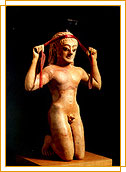Awarding the prizes
The victors at the Olympic games, wearing a red wool stripe on
their heads and holding a palm branch on their right hand,
 entered
the temple of Zeus. The wool stripe was usually used to adorn
sacred objects and the palm branch commemorated Theseus, who
established the games in Delos, where the victors were crowned
by a palm branch. Inside the temple were the olive-tree wreaths,
the so-called kotinoi, placed on a gold and ivory table. The
bronze tripod, on which the wreaths were placed during earlier
times, was now kept in the temple. The Olympic victors were
crowned with this precious prize. As a matter of fact, it
was widely believed that the wreath added magical qualities
to the athlete. The victor became the favorite of the gods,
because he had won with their assistance. This ceremony symbolized
the mystical communication between the divinity and man. entered
the temple of Zeus. The wool stripe was usually used to adorn
sacred objects and the palm branch commemorated Theseus, who
established the games in Delos, where the victors were crowned
by a palm branch. Inside the temple were the olive-tree wreaths,
the so-called kotinoi, placed on a gold and ivory table. The
bronze tripod, on which the wreaths were placed during earlier
times, was now kept in the temple. The Olympic victors were
crowned with this precious prize. As a matter of fact, it
was widely believed that the wreath added magical qualities
to the athlete. The victor became the favorite of the gods,
because he had won with their assistance. This ceremony symbolized
the mystical communication between the divinity and man.
According to tradition, Iphitos was the one who established for the first time the wild olive-tree wreath as a prize, obeying an oracle from Delphi. The branch was always cut from the same wild olive-tree, the Kallistephanos, which lay near the temple of Zeus. The other panhellenic contests also presented victors with a wreath as a prize, for example in the Pythian a wreath of laurel, in the Isthmia of a pine tree and in the Nemean of celery.
|
